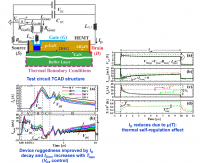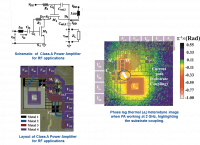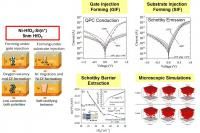Scientific Highlights
This section includes a list of the highlighted IMB-CNM scientific papers published in journals included in the Science Citation Index (SCI), per year of publication.

The development of an amperometric biosensor for L-malate determination showing long-term stability is reported in this work. The biosensor is based on a thin-film gold electrochemical transducer and a three-dimensional membrane of polypyrrole entrapping malate dehydrogenase and diaphorase enzymes. It was applied to monitor the malolactic fermentation of three red wines, showing a good agreement with the standard colorimetric method.
Anal. Chim. Acta 954 (2017) 105-113.

This paper studies by experimentation and physics-based simulation the Short-Circuit (SC) capability of several normally-off 600-650 V Gallium Nitride High-Electron-Mobility Transistors (GaN HEMTs): cascodes, p-GaN, and GaN Metal-Insulator-Semiconductor HEMTs (MISHEMTs). As a result, cascodes present the worst SC ruggedness. By contrast, p-GaN gate HEMTs and MISHEMTs provide a higher SC capability thanks to their strong drain current reduction. In addition, a valuable state-of-the-art about all commercially available technologies is also provided, which demonstrates that current GaN devices do not allow SC capability.
IEEE Transactions on Industrial Electronics, 64 (11), pp. 9012-9022 (2017).

Gallium Nitride High-Electron-Mobility Transistors (GaN HEMTs) are promising devices for high-frequency and high-power density converters, but some of their applications (e.g., motor drives) require high robustness levels. In this scenario, 600 V normally-off p-GaN gate HEMTs are studied under short-circuit (SC) by experiment and physics-based simulations (drift-diffusion and thermodynamic models). As a main observation, a strong drain current reduction (> 70% after saturation peak) and high gate leakage current (tens of mA) are observed. All studied devices withstand the SC test at bus voltages up to 350 V, while fail at 400 V. Furthermore, its understanding is crucial to improving SC ruggedness in p-GaN HEMTs
IEEE Electron Device Letters, 38 (4), pp. 505-508 (2017).

With thermal phase lag measurements, current paths are tracked in a Class A Radio Frequency (RF) power amplifier at 2 GHz. The phase lag maps evidence with a higher sensitivity than thermal amplitude measurements, an input-output loop due to a substrate capacitive coupling. This limits the amplifier’s performance, raising the power consumption in certain components. Other information relative to local power consumption and amplifier operation is also inferred. This approach allows the local non-invasive testing of integrated systems regardless of their operating frequency.
Appl. Phys. Lett., 101 (2) 094101 (2017).

The physical and chemical properties of silicon chips can be tuned to address the requirements of the research. The control of the physical anisotropy from fabrication allows obtaining chips with the desired aspect ratio, branching, faceting and size. Subsequent surface modification via wet chemistry or contact printing added two- and 3-dimensional chemical features on each microparticle. The combination of physical and chemical anisotropies provides the mean to create a myriad of customized microparticles.
Adv. Funct. Mater. 2017.

This work reports on the design, fabrication and performance of a low-cost, self-contained sampling device based on a wax microfluidics technology. This sampler delivers leak- and contamination-free performance that ensures the integrity of the collected samples. Thanks to its small dimensions and low power requirements, this device is well suited for collecting samples on-board of small aerial or aquatic drones.
Sensors and Actuators B 251 (2017) 93–98

An impedimetric sensor based on a three dimensional electrode array modified with consecutive deposition of Con A-glycogen-Con A layers was used for label-free detection of bacterial endotoxin: lipopolysaccharide (LPS) from Escherichia coli. Presented biosensor is able to detect bacterial LPS in a very short detection time (20 min) with 2 μg mL−1 limit of detection, which is much lower than reported for other biosensors with Con A.
Electroquimica Acta, 2017, vol.243, pp.142-151

The impact of the dielectric thickness, forming polarity, and current compliance on the self-rectifying current–voltage characteristics of Ni/HfO2/n+-Si RRAM devices has been investigated. In the case of 5-nm-thick oxide devices, a self-rectifying ratio of three orders of magnitude is observed after substrate injection forming (SIF) with current compliance below 500 μA. However, devices subjected to gate injection forming (GIF) do not exhibit such rectifying feature. This distinctive behavior for SIF is ascribed to the formation of a Schottky-like contact in between the Ni-based conducting filament and the semiconductor electrode.
IEEE Trans. Electron Dev. 64 (8) pp 3159-3166 (2017).

Several thermal management strategies for LED drivers designed for high lumen retrofit LED lamps are studied by simulation and experimentation means. Depending on the driver output, two scenarios are analyzed: Low Voltage-High Current (18V-620mA) and High Voltage-Low Current (110V-85mA). Experiments (infrared thermography and thermocouples) and multiscale simulation approaches are used to assist both the lamp and driver board thermal design, as well as the driver proper integration in the lighting system. As a result, a heatsink based on an Aluminum hollow cylinder with polymer axial fins is designed and evaluated. The heatsink assessement is carried out with an LED board, in which the LED junction temperature is modeled and extracted by monitoring the LED board backside temperature. Additional experimentation to better integrate the driver is performed aiming at reducing the contact thermal resistance between the driver and the heatsink and improving the heat removal in the driver housing by including a material with a high thermal conductivity (i.e., dry silica sand or magnesium oxide powder). The proposed solution reduces the LED junction temperature up to 18% with respect to a reference lamp, whereas both drivers depict working temperatures around or below 125°C, when a working temperature of 90°C is considered.
IEEE Transactions on Power Electronics.

A novel impedance-based aptasensor for detection of E. coli O157:H7 is proposed. The limit of detection of the biosensor is around 102 cfu·mL-1 with a detection time of 30 minutes. The selectivity of the developed aptasensor is demonstrated in regard to other bacterial strains. Regeneration protocol for the aptasensor, to be employed more than once, has been developed
Sensors & Actuators: B. Chemical V. 255 P3 (2018) pp. 2988-2995.




